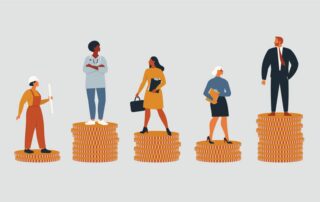Status of Women in the States
IWPR’s Status of Women in the States project provides data and analysis on the health, economic, social, political well-being of women. The project provides state-by-state rankings on issues such as pay equity and earnings; poverty and economic security; reproductive rights and access to health care and political participation and civic engagement.

Latinas Will Not Reach Pay Equity with White Men until 2207 if Current Trends Persist
In 2022, Latinas working full-time year-round were paid just 57.5 cents for every dollar paid to White, non-Hispanic men nationally (a wage gap of 42.5 percent). Among all workers, including those working full-time, part-time, full-year, or part- year, Latinas were paid only 51.9 cents [...]
Gender and Racial Wage Gaps Marginally Improve in 2022 but Pay Equity Still Decades Away
In 2022, women working full-time year-round made 84.0 cents per dollar earned by men (a wage gap of 16.0 percent), a marginal improvement compared to 2021 (83.7 cents per dollar) and significantly higher than in pre-COVID-19 2019 (82.3 cents).1 Based on median annual earnings [...]
Quick Figure: Pay Equity Still Decades Away
If progress continues at the same rate as it has since 1960, it will still take more than three decades, until 2053, for all working women to reach pay equity with men. It will take even longer, until 2058, to reach full pay equity [...]
State by State, Mothers Are Paid Much Less Than Fathers
Mothers earned less than fathers prior to the COVID-19 pandemic, during the pandemic, and as the economy began to recover from the pandemic. In 2021, the most recently available annual earnings data, the median annual earnings for mothers amounted to just 61.7 cents on [...]
In 2021, Working Moms Made Just 62 Cents on the Dollar Compared to Working Fathers in Every U.S. State, According to New IWPR Fact Sheet
FOR IMMEDIATE RELEASE August 15, 2023 Contact: William Lutz 202-785-5100 Mom’s Equal Pay Day is August 15, 2023 Washington, D.C. — Nationally, in 2021 working moms made just 61.7 cents on the dollar compared to working fathers, according to a new Fact Sheet released by [...]
Black Women Earn Less Than White Men in Every State, Won’t Reach Pay Equity Until 2144
The COVID-19 pandemic and related recession both highlighted and exacerbated the persistent racial and gendered economic inequalities that Black women face in the labor market. Whether they worked full-time, part-time, year-round, or part-year, Black women were paid substantially less than White men. This brief [...]





